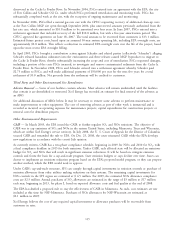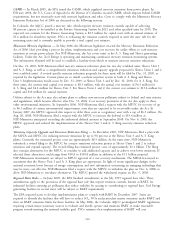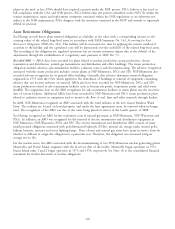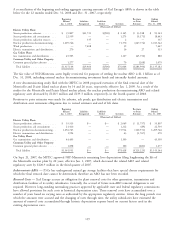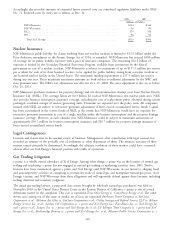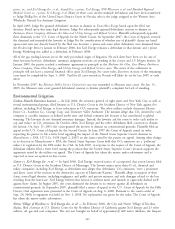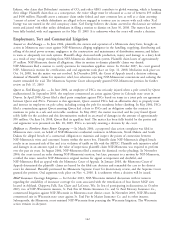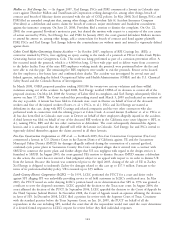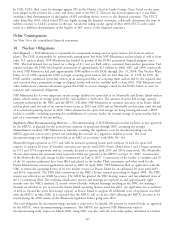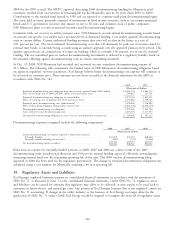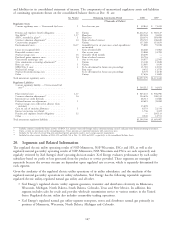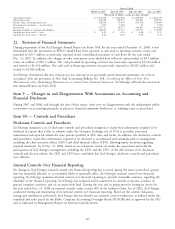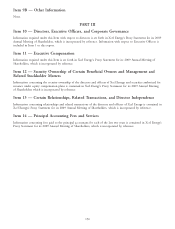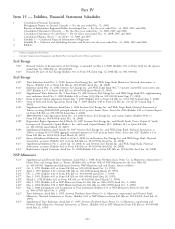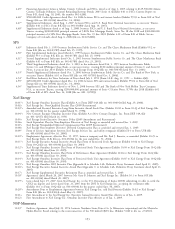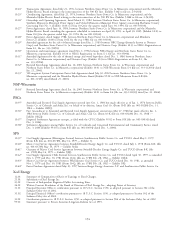Xcel Energy 2008 Annual Report Download - page 155
Download and view the complete annual report
Please find page 155 of the 2008 Xcel Energy annual report below. You can navigate through the pages in the report by either clicking on the pages listed below, or by using the keyword search tool below to find specific information within the annual report.In 1996, LCEC filed a suit for damages against SPS in the District Court in Lamb County, Texas, based on the same
facts alleged in the petition for a cease and desist order at the PUCT. This suit has been dormant since it was filed,
awaiting a final determination of the legality of SPS providing electric service to the disputed customers. The PUCT
order from May 2003, which found SPS was legally serving the disputed customers, collaterally determines the issue of
liability contrary to LCEC’s position in the suit. An adverse ruling on the appeal of May 2003 PUCT order could
result in a different determination of the legality of SPS’ service to the disputed customers.
Other Contingencies
See Note 16 to the consolidated financial statements.
18. Nuclear Obligations
Fuel Disposal — NSP-Minnesota is responsible for temporarily storing used or spent nuclear fuel from its nuclear
plants. The DOE is responsible for permanently storing spent fuel from NSP-Minnesota’s nuclear plants as well as from
other U.S. nuclear plants. NSP-Minnesota has funded its portion of the DOE’s permanent disposal program since
1981. The fuel disposal fees are based on a charge of 0.1 cent per Kwh sold to customers from nuclear generation. Fuel
expense includes the DOE fuel disposal assessments of approximately $13 million in 2008, 2007 and 2006, respectively.
In total, NSP-Minnesota had paid approximately $386 million to the DOE through Dec. 31, 2008. The Nuclear Waste
Policy Act of 1982 required the DOE to begin accepting spent nuclear fuel no later than Jan. 31, 1998. In 1996, the
DOE notified commercial spent-fuel owners of an anticipated delay in accepting spent nuclear fuel by the required date
and conceded that a permanent storage or disposal facility will not be available until at least 2010. NSP-Minnesota and
other utilities have commenced lawsuits against the DOE to recover damages caused by the DOE’s failure to meet its
statutory and contractual obligations.
NSP-Minnesota has its own temporary on-site storage facilities for spent fuel at its Monticello and Prairie Island nuclear
plants, which consist of storage pools and dry cask facilities at both sites. The amount of spent fuel storage capacity
currently authorized by the NRC and the MPUC will allow NSP-Minnesota to continue operation of its Prairie Island
nuclear plant until the end of its current license terms in 2013 and 2014 and its Monticello nuclear plant until the end
of its renewed operating license in 2030. Other alternatives for spent fuel storage are being investigated until a DOE
facility is available, including pursuing the establishment of a private facility for interim storage of spent nuclear fuel as
part of a consortium of electric utilities.
Regulatory Plant Decommissioning Recovery — Decommissioning of NSP-Minnesota’s nuclear facilities, as last approved
by the MPUC, is planned for the period from cessation of operations through 2067, assuming the prompt
dismantlement method. NSP-Minnesota is currently recording the regulatory costs for decommissioning over the
MPUC-approved cost-recovery period and including the accruals in a regulatory liability account. The total
decommissioning cost obligation is recorded as an ARO in accordance with SFAS No. 143.
Monticello began operation in 1971 and with its renewed operating license and certificate of need for spent fuel
capacity to support 20 years of extended operation can operate until 2030. Prairie Island units 1 and 2 began operation
in 1973 and 1974, respectively, and are currently licensed to operate until 2013 and 2014, respectively. The Monticello
20-year depreciation life extension until September 2030 was granted by the MPUC on Sept. 21, 2007. Construction
of the Monticello dry-cask storage facility commenced on June 4, 2007. Construction of the facility is complete and 10
of the 30 canisters authorized have been filled and placed in the facility. Plant assessments and other work for the
Prairie Island license renewal applications started in 2006. In April 2008, NSP-Minnesota filed an application with the
NRC to renew the operating license of its two nuclear reactors at Prairie Island for an additional 20 years until 2033
and 2034, respectively. The PIIC filed contentions in the NRC’s license renewal proceeding in August 2008. The PIIC
request was referred to an ASLB for review. The ASLB has granted the PIIC hearing request and has admitted seven of
the 11 contentions filed. The resulting adjudicatory process and hearings are expected to add approximately eight
months onto the NRC’s standard 22 month review schedule (without hearings) resulting in the NRC not making a
decision on whether or not to renew the Prairie Island operating licenses until late 2010. An application for a certificate
of need to expand the spent fuel storage capacity at Prairie Island to support 20 additional years of operation was filed
with the MPUC in May 2008. It is expected that the MPUC will act in late 2009 allowing the MPUC decision to be
stayed during the 2010 session of the Minnesota legislature before going into effect.
The total obligation for decommissioning currently is expected to be funded 100 percent by external funds, as approved
by the MPUC, when decommissioning commences. The MPUC last approved NSP-Minnesota’s nuclear
decommissioning study request in March 2006, using 2005 cost data with the next study update submitted in October
145


